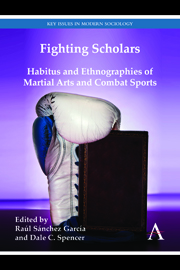Book contents
- Frontmatter
- Dedication
- Epigraph
- Contents
- Contributors
- Glossary
- Chapter 1 Introduction: Carnal Ethnography as Path to Embodied Knowledge
- Chapter 2 Habitus as Topic and Tool: Reflections on Becoming a Prizefighter
- Chapter 3 In Search of a Martial Habitus: Identifying Core Dispositions in Wing Chun and Taijiquan
- Chapter 4 Each More Agile Than the Other: Mental and Physical Enculturation in Capoeira Regional
- Chapter 5 ‘There Is No Try in Tae Kwon Do’: Reflexive Body Techniques in Action
- Chapter 6 ‘It Is About Your Body Recognizing the Move and Automatically Doing It’: Merleau-Ponty, Habit and Brazilian Jiu-Jitsu
- Chapter 7 ‘Do You Hit Girls?’: Some Striking Moments in the Career of a Male Martial Artist
- Chapter 8 The Teacher's Blessing and the Withheld Hand: Two Vignettes of Somatic Learning in South India's Indigenous Martial Art Kalarippayattu
- Chapter 9 White Men Don't Flow: Embodied Aesthetics of the Fifty-Two Hand Blocks
- Chapter 10 Japanese Religions and Kyudo (Japanese Archery): An Anthropological Perspective
- Chapter 11 Taming the Habitus: The Gym and the Dojo as ‘Civilizing Workshops’
- Chapter 12 ‘Authenticity’, Muay Thai and Habitus
- Chapter 13 Conclusion: Present and Future Lines of Research
- Epilogue Homines in Extremis: What Fighting Scholars Teach Us about Habitus
- References
Chapter 2 - Habitus as Topic and Tool: Reflections on Becoming a Prizefighter
Published online by Cambridge University Press: 05 March 2014
- Frontmatter
- Dedication
- Epigraph
- Contents
- Contributors
- Glossary
- Chapter 1 Introduction: Carnal Ethnography as Path to Embodied Knowledge
- Chapter 2 Habitus as Topic and Tool: Reflections on Becoming a Prizefighter
- Chapter 3 In Search of a Martial Habitus: Identifying Core Dispositions in Wing Chun and Taijiquan
- Chapter 4 Each More Agile Than the Other: Mental and Physical Enculturation in Capoeira Regional
- Chapter 5 ‘There Is No Try in Tae Kwon Do’: Reflexive Body Techniques in Action
- Chapter 6 ‘It Is About Your Body Recognizing the Move and Automatically Doing It’: Merleau-Ponty, Habit and Brazilian Jiu-Jitsu
- Chapter 7 ‘Do You Hit Girls?’: Some Striking Moments in the Career of a Male Martial Artist
- Chapter 8 The Teacher's Blessing and the Withheld Hand: Two Vignettes of Somatic Learning in South India's Indigenous Martial Art Kalarippayattu
- Chapter 9 White Men Don't Flow: Embodied Aesthetics of the Fifty-Two Hand Blocks
- Chapter 10 Japanese Religions and Kyudo (Japanese Archery): An Anthropological Perspective
- Chapter 11 Taming the Habitus: The Gym and the Dojo as ‘Civilizing Workshops’
- Chapter 12 ‘Authenticity’, Muay Thai and Habitus
- Chapter 13 Conclusion: Present and Future Lines of Research
- Epilogue Homines in Extremis: What Fighting Scholars Teach Us about Habitus
- References
Summary
In this chapter, I recount how I took up the ethnographic craft; stumbled upon the Chicago boxing gym that is the main scene and character of my ethnography of prizefighting in the black American ghetto; and designed the book Body and Soul that reports on its findings so as to both deploy methodologically and elaborate empirically Pierre Bourdieu's signal concept of habitus (Wacquant 2004a). I draw out some of the biographical, intellectual and analytic connections between this research project on a plebeian bodily craft, the theoretical framework that informs it, and the macro-comparative inquiry into urban marginality of which it is an unplanned offshoot. I sketch how the practicalities of fieldwork led me from the ghetto as implement of ethnoracial domination to embodiment as a problem and resource for social inquiry. Through this reflection on becoming a prizefighter, I argue for the use of fieldwork as an instrument of theoretical construction, the potency of carnal knowledge, and the imperative of epistemic reflexivity. I also stress the need to expand the textual genres and styles of ethnography so as to better capture the Sturm und Drang of social action as it is manufactured and lived.
The concept of habitus supplied at once the anchor, the compass and the course of the ethnographic journey recapped in Body and Soul. It is the topic of investigation: the book dissects the forging of the corporeal and mental dispositions that make up the competent boxer in the crucible of the gym. But it is also the tool of investigation: the practical acquisition of those dispositions by the analyst serves as technical vehicle for better penetrating their social production and assembly. In other words, the apprenticeship of the sociologist is a methodological mirror of the apprenticeship undergone by the empirical subjects of the study; the former is mined to dig deeper into the latter and unearth its inner logic and subterranean properties; and both in turn test the robustness and fruitfulness of habitus as guide for probing the springs of social conduct.
- Type
- Chapter
- Information
- Fighting ScholarsHabitus and Ethnographies of Martial Arts and Combat Sports, pp. 19 - 32Publisher: Anthem PressPrint publication year: 2013

